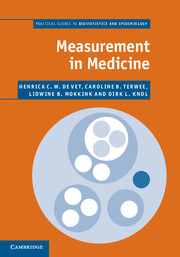Book contents
- Frontmatter
- Contents
- Preface
- 1 Introduction
- 2 Concepts, theories and models, and types of measurements
- 3 Development of a measurement instrument
- 4 Field-testing: item reduction and data structure
- 5 Reliability
- 6 Validity
- 7 Responsiveness
- 8 Interpretability
- 9 Systematic reviews of measurement properties
- References
- Index
6 - Validity
Published online by Cambridge University Press: 07 September 2011
- Frontmatter
- Contents
- Preface
- 1 Introduction
- 2 Concepts, theories and models, and types of measurements
- 3 Development of a measurement instrument
- 4 Field-testing: item reduction and data structure
- 5 Reliability
- 6 Validity
- 7 Responsiveness
- 8 Interpretability
- 9 Systematic reviews of measurement properties
- References
- Index
Summary
Introduction
Validity is defined by the COSMIN panel as ‘the degree to which an instrument truly measures the construct(s) it purports to measure’ (Mokkink et al., 2010a). This definition seems to be quite simple, but there has been much discussion in the past about how validity should be assessed and how its results should be interpreted. Psychologists, in particular, have struggled with this problem, because, as we saw in Chapters 2 and 3, they often have to deal with ‘unobservable’ constructs. This makes it difficult for them to judge whether they are measuring the right thing. In general, three different types of validity can be distinguished: content validity, criterion validity and construct validity. Content validity focuses on whether the content of the instrument corresponds with the construct that one intends to measure, with regard to relevance and comprehensiveness. Criterion validity, applicable in situations in which there is a gold standard for the construct to be measured, refers to how well the scores of the measurement instrument agree with the scores on the gold standard. Construct validity, applicable in situations in which there is no gold standard, refers to whether the instrument provides the expected scores, based on existing knowledge about the construct. Within these three main types of validity, there are numerous subtypes, as we will see later in this chapter.
- Type
- Chapter
- Information
- Measurement in MedicineA Practical Guide, pp. 150 - 201Publisher: Cambridge University PressPrint publication year: 2011
- 20
- Cited by



